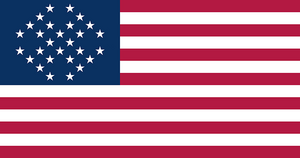United States of America (FTA)
| The United States of America | |||||
|---|---|---|---|---|---|
| United States | |||||
| |||||
| Motto | |||||
| E pluribus unum | |||||
| Anthem | |||||
| The Star Spangled Banner | |||||
| March | |||||
| The Stars and Stripes Forever | |||||
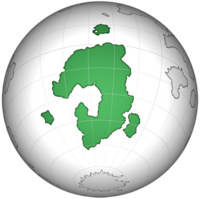
| |||||
| New America, Elysium | |||||
| Capital | Columbia, New America | ||||
| Largest City | Midway, New America | ||||
| Official languages | None at the Federal level | ||||
| National languages | English, Spanish | ||||
| Regional languages | Hebrew, Arabic, German, French | ||||
| Demonym | American | ||||
| Government | Federal Republic | ||||
| - President | Datoka Metropolis | ||||
| - Vice President | Joshua Masters | ||||
| - Speaker of the House | Justin Alexandrou | ||||
| Legislature | Congress | ||||
| -Upper House | Senate | ||||
| -Lower House | House of Representatives | ||||
| Independence from Great Britain | |||||
| - Declaration of Independence | 1776 | ||||
| - Third Constitutional Convention | 21XX | ||||
| - Last polity admitted | 2315 | ||||
| Area | |||||
| Population | |||||
| Estimate | 1,472,500,000 | ||||
| Currency | United States Dollar | ||||
| Time Zone | |||||
| Drives on the | right | ||||
| Date Format | mm/dd/yyyy | ||||
The United States remains as it ever was, a Federal Republic of States founded in 1776. Contrary to certain inaccurate histories it weathered the collapse of the Second Republic's governance system, brutally exposed during the ashfall disaster. This catastrophe led to the secession of several states, including all of the original states of North America. Those who remained loyal, faced with intractable constitutional gridlock and a system of government clearly showing its age convened convened the third Constitutional convention on Elysium, to resolve these issues and restore stability. The outcome after nearly half a year of deliberation was the inauguration of the Third American Republic.
Etymology
The first documentary evidence of the phrase "United States of America" dates to a letter from January 2, 1776, written by Stephen Moylan, a Continental Army aide to General George Washington, to Joseph Reed, Washington's aide-de-camp. Moylan expressed his desire to go "with full and ample powers from the United States of America to Spain" to seek assistance in the Revolutionary War effort.
History
Main Article: History of the United States 20th/21st Century
In the aftermath of a devastating ashfall that plunged the heartlands of the United States into chaos, the nation stood on the precipice of collapse.
Amidst this turmoil, Samuel Winters emerged as a pivotal figure. As ash choked the skies and obscured the sun, the heartland states suffered. Secessionist sentiments ran high, and the Federal government began to crumble. Desperate local and state governments increasingly had to take matters normally the preserve of the Federal government.
With states seceding from the Union and the Federal government in complete disarray, Samuel Winters recognised that any chance of keeping what was left of America afloat lay in the colonies. There secessionist sentiment was particularly weak, with the old colonial settlements of New America fearful of complete breakup.
Winters, a New American native was popular in the colonial states and was recognised as President by the governors of the New American States and for several years oversaw the vast inflows of refugees to Elysium. It was President Winters who steered the Union through the hard months of the Constitutional Convention and the signing of the New Treaty of New York, relinquishing claims to the secessionist states and ultimately seeking a shared future as Americans over revanchism.
Geography
Commonwealths & Territories The United States has principle territories are located on Elysium, Terranova, Prospect, Santa Maria, Mars and Luna.
Government and Politics
National Government
The United States is a federal republic of 28 states, with its capital in a federal district, asserting sovereignty over eight unincorporated territories and Commonwealths. It is the world's oldest surviving federation, and, according to the World Economic Forum, the oldest democracy as well. It is a liberal representative democracy "in which majority rule is tempered by minority rights protected by law." The Constitution of the United States serves as the country's supreme legal document, also establishing the structure and responsibilities of the national federal government and its relationship with the individual states.
U.S. Congress
Main Article: United_States_Congress
The U.S. Congress consists of a bicameral legislature, made up of a Upper House and Lower House, called the Senate and House of Representatives. They make federal law, declare war, approve treaties and have the power of purse and impeachment. The Senate has 28 'State' Senators and another 100 allocated on the basis of population, elected to a six year term. The House of Representatives has 1035 members from single member congressional districts, allocated on the basis of population, elected for a two year term. Both the Senate and House of Representatives are elected by ranked choice voting.
US Capitol
The U.S. Congress sits in the United States Capitol. With the loss of the old capitol with the secession of the Earth states, a new capitol based on alternative designs was constructed in New America.
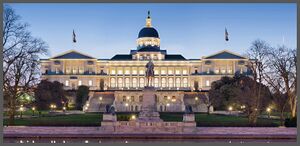
Executive Branch
The U.S. president is the commander-in-chief of the military, can veto legislative bills before they become law (subject to congressional override), and appoints the members of the Cabinet (subject to Senate approval) and other officials, who administer and enforce federal laws and policies through their respective agencies. The president and the vice president run and are elected together in a presidential election. The President is elected by direct popular vote, should any candidate fail to achieve 50%, a run-off election is held between the two top candidates. The President and Vice President serve a four-year term and may be elected to the office no more than three times.
Jefferson House
The Presidential Residence is known as the Jefferson House. It is based on an alternative design of the White House by Thomas Jefferson.
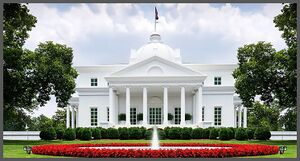
Federal Judiciary
The U.S. federal judiciary, whose judges are all appointed for life by the President with Senate approval, consists primarily of the U.S. Supreme Court, the U.S. courts of appeals, and the U.S. district courts. The U.S. Supreme Court interprets laws and overturn those they find unconstitutional. The Supreme Court is led by the Chief Justice of the United States. It has nine members who serve for 18 year terms. The members are appointed by the sitting president when their term ends, giving each Presidential term an equal number of appointments.
Supreme Court Building
The Supreme Court Building in Columbia, New America.
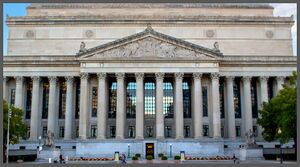
Political Parties
The two main national coalitions are presently, the New American Century Caucus and the Democratic-Republican Coalition. The former is perceived as relatively liberal in its political platform while the latter is perceived as relatively conservative though this is on a spectrum of a progressive liberal nation. The Democratic-Republic Coalition won the 2324 elections, with President Dakota Metropolis starting her first term as President.
The emergence of coalition politics is generally attributed to campaign finance laws integrated into the US Constitution. All forms of private campaign finance are banned under the US Constitution, with State and Federal elections both publicly funded. Combined with an open primary system and initial funding based on collecting sufficient ballots to register, numerous political parties are supported leading to the formation of coalition politics in order to pass legislation.
Democratic-Republican Coalition
The Democratic-Republic Coalition is a center-right coalition of the Democrat and Republican parties, formed in 2124. The party's platform blends civil liberty and social equality with support for a mixed capitalist economy. It believes more strongly in individual liberties and free markets than the New American Century Caucus and is also more sceptical of foreign interventions.
New American Century Caucus
The New American Century Caucus is a center-left coalition of the Progressive Party, H+ International. The party's platform is support for civil liberty, but also social equity and favors a strongly regulated mixed capitalist economy and supports strong bodily autonomy rights. It favors foreign interventions and the doctrine of right to protect.
America Homeland Party
The American Homeland Party is a isolationist party, against foreign entanglements and for the government to concentrate on New America.
Economy
The United States is the largest economy on the grid, a position it achieved in 2295 some 150 years after losing the position in the wake of the deluge. It is a mixed market economy, all major utilities are publicly owned but most services without a 'natural monopoly' are private enterprises in a regulated market.
The United States economy is structured around the service and manufacturing sectors, with manufacturing focused on civilian goods such as ground-cars, grav cars, light shuttlecraft and high end low volume products such as anti-gravity coils, fusion reactors and atmospheric processors. The United States economy experiences a average growth rate of 2% a year.
Midway City is the United States principle financial center, as well as being a key financial hub across the entire grid.
Universal Credit
With significant automation present in many industries and a large diverse population, the Federal government instituted a system of Universal basic income to ensure that every American had a good standard of living. The minimum amount is tied to a basic set of goods reviewed every 5 years, to ensure everyone has access to not just basic necessities, but can afford consumer electronics, media, social events and vacations. Most Americans not directly participating in work either volunteer or engage in various hobbies that economists believe has stimulated further growth, ensuring that even the 'economically inactive' are in fact productive contributors to America's economic standing.
Demographics
The U.S. Census Bureau reported 1,472,500,000 residents as of April 1, 2423 making the United States the third-most-populous country in the grid, after Tainshang and the Grand Dale Charter. In 2421 the total fertility rate for the U.S stood at 2.2 children per woman.
The largest city in the United States is Midway, with a population of 47 million.
The United States has a diverse population; with over 150 different ethnic groups and over 300 different languages spoken. English is the most common language and is spoken fluently by 92% of the population. Of these, 68% spoke the language exclusively at home, followed by Spanish at 18%. Furthermore, 87% of citizens have the standard suite of WHO recommended genetic alternations, with the reminder refusing on cultural or religious grounds. In 2021, 77% of American reported possessing some form of cybernetic implant. 15% of citizens belong to one of several transgenic clades, including Feline, Canine and Amphibs.
America's immigrant population, 210 million, is one of the largest on the grid. There were 350 million immigrants and U.S.-born children of immigrants in the United States, accounting for nearly 25% of the overall U.S. population.
Culture and Society
The foundation of American society and culture is the US Constitution and it's bill of rights. The unifying political belief in an American Creed emphasising individual liberty, political equity, economic equality and equal treatment under the rule of law. Culturally the country has a strong ethic of individualism, personal responsibility and a strong ethic of voluntary service and contributing culturally to society.
With the United States broadly encouraging immigration, it is perhaps the most pluralist society on the grid, welcoming people from nearly every culture. The constitution right to freedom of belief and near absolute freedom of speech attract a wide variety of people from across the grid. The ability of the United States to assimilate a wide variety of groups to adhere to the core American creed has been considered a core strength of American cultural cohesion.
